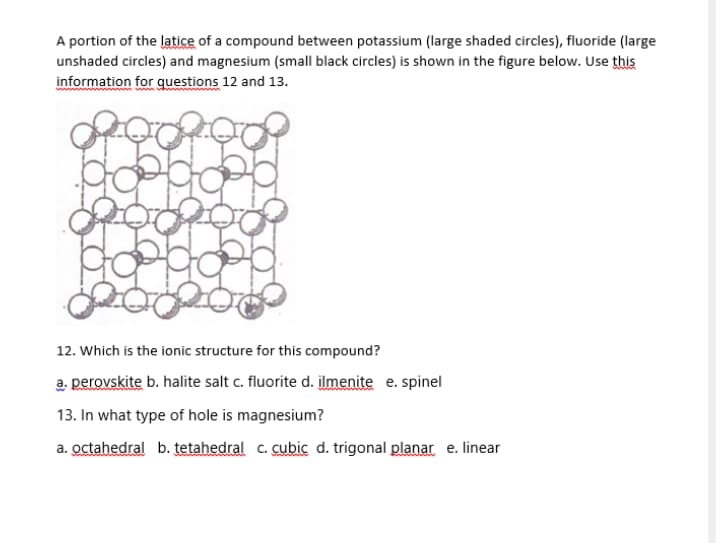A portion of the latice of a compound between potassium (large shaded circles), fluoride (large unshaded circles) and magnesium (small black circles) is shown in the figure below. Use this information for questions 12 and 13. 12. Which is the ionic structure for this compound? a. perovskite b. halite salt c. fluorite d. ilmenite e. spinel 13. In what type of hole is magnesium? a. octahedral b. tetahedral c. cubic d. trigonal planar e. linear
A portion of the latice of a compound between potassium (large shaded circles), fluoride (large unshaded circles) and magnesium (small black circles) is shown in the figure below. Use this information for questions 12 and 13. 12. Which is the ionic structure for this compound? a. perovskite b. halite salt c. fluorite d. ilmenite e. spinel 13. In what type of hole is magnesium? a. octahedral b. tetahedral c. cubic d. trigonal planar e. linear
Chemistry & Chemical Reactivity
10th Edition
ISBN:9781337399074
Author:John C. Kotz, Paul M. Treichel, John Townsend, David Treichel
Publisher:John C. Kotz, Paul M. Treichel, John Townsend, David Treichel
Chapter12: The Solid State
Section: Chapter Questions
Problem 30PS: The structure of graphite is given in Figure 12.19. (a) What type of intermolecular forces exist...
Related questions
Question

Transcribed Image Text:A portion of the latice of a compound between potassium (large shaded circles), fluoride (large
unshaded circles) and magnesium (small black circles) is shown in the figure below. Use this
information for questions 12 and 13.
12. Which is the ionic structure for this compound?
a. perovskite b. halite salt c. fluorite d. ilmenite e. spinel
13. In what type of hole is magnesium?
a. octahedral b. tetahedral c. cubic d. trigonal planar e. linear
Expert Solution
This question has been solved!
Explore an expertly crafted, step-by-step solution for a thorough understanding of key concepts.
Step by step
Solved in 2 steps

Knowledge Booster
Learn more about
Need a deep-dive on the concept behind this application? Look no further. Learn more about this topic, chemistry and related others by exploring similar questions and additional content below.Recommended textbooks for you

Chemistry & Chemical Reactivity
Chemistry
ISBN:
9781337399074
Author:
John C. Kotz, Paul M. Treichel, John Townsend, David Treichel
Publisher:
Cengage Learning

Chemistry & Chemical Reactivity
Chemistry
ISBN:
9781133949640
Author:
John C. Kotz, Paul M. Treichel, John Townsend, David Treichel
Publisher:
Cengage Learning

Chemistry for Engineering Students
Chemistry
ISBN:
9781337398909
Author:
Lawrence S. Brown, Tom Holme
Publisher:
Cengage Learning

Chemistry & Chemical Reactivity
Chemistry
ISBN:
9781337399074
Author:
John C. Kotz, Paul M. Treichel, John Townsend, David Treichel
Publisher:
Cengage Learning

Chemistry & Chemical Reactivity
Chemistry
ISBN:
9781133949640
Author:
John C. Kotz, Paul M. Treichel, John Townsend, David Treichel
Publisher:
Cengage Learning

Chemistry for Engineering Students
Chemistry
ISBN:
9781337398909
Author:
Lawrence S. Brown, Tom Holme
Publisher:
Cengage Learning


Chemistry
Chemistry
ISBN:
9781305957404
Author:
Steven S. Zumdahl, Susan A. Zumdahl, Donald J. DeCoste
Publisher:
Cengage Learning

Chemistry: An Atoms First Approach
Chemistry
ISBN:
9781305079243
Author:
Steven S. Zumdahl, Susan A. Zumdahl
Publisher:
Cengage Learning